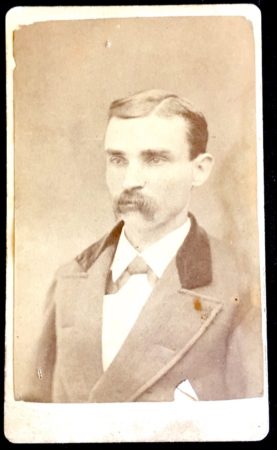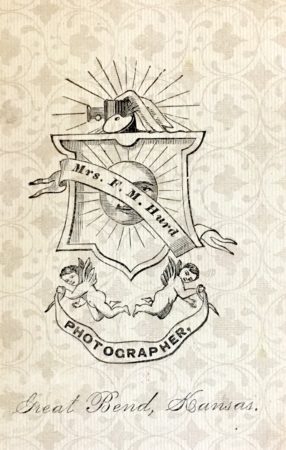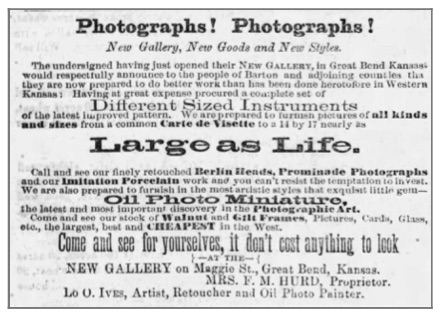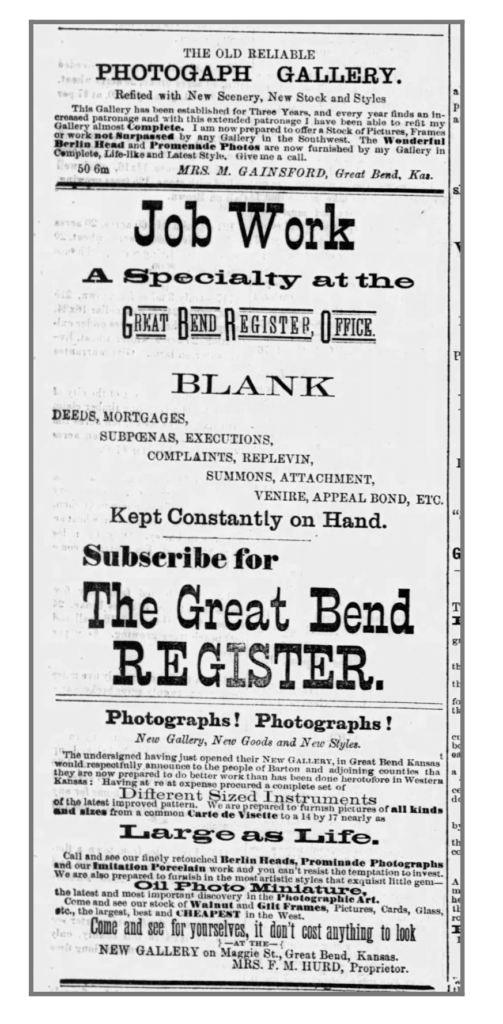Notes
Here is the CDV we stumbled upon recently that led my husband, Chris, to discover the incredible story of the photographer Mrs. F. M. Hurd:


Here’s an ad in the newspaper for Mrs. Hurd’s new photo gallery when it opened in April 1877:

Interestingly, a couple of weeks later, a column of ads on the same page of the newspaper has advertisements for the 2 competing photography galleries: at the top is an ad for Mrs. Gainsford’s gallery; at the bottom an ad for Mrs. Hurd’s gallery (in the middle of the column is an ad that is NOT for a photograph gallery).:

Here’s a link to a writeup about Frankie Morris’ trial on the Murder by Gaslight website. Included in the writeup is a sketch of Frankie Morris Loveland that appear in the newspaper during one of her trials.
Note that the Murder by Gaslight site does not include the information that Frankie Morris Loveland was once Mrs. F.M. Hurd, photographer, prior to her mother’s untimely death. Thanks to my husband, Chris Culy, for tracking that down and piecing it all together! 🙂
Lifeline

Recommended Links
- Ancestry.com (census records, city directories, and more; paid account required – Visit
- Family Search website has U.S. Federal Census and more; free account required – Visit
- Geneologybank.com has a selection of digitized newspapers from the United States; paid account required – Visit
- The Library Company of Philadelphia website – Visit
- Newspapers.com has a selection of digitized newspapers from the United States; paid account required – Visit
- Newspaperarchives.com has a selection of digitized newspapers from the United States; paid account required – Visit
- Peter Palmquist database at the Yale Beinecke Library – Visit
Transcript
You’re listening to Photographs, Pistols & Parasols.
Support for this project is provided by listeners like you. Visit my website at p3photographers “dot” net for ideas on how you, too, can become a supporter of the project.
Welcome to Photographs, Pistols & Parasols, the podcast where we celebrate early women artisan photographers.
I’m your host, Lee McIntyre.
In today’s episode, we have the fascinating tale of the photographer Mrs. F.M. Hurd of Great Bend, Kansas.
For more information about any of the women discussed in today’s episode, visit my website at p3photographers.net.
That’s letter “p”, number “3”, photographers “dot” net.
*******
Hi everybody.
Today our story starts with a photograph.
It’s just a little Carte de Visite of a man with a mustache done by a Mrs. F. M. Hurd.
As a photograph, it’s okay. But it’s not terribly remarkable.
But the story that discovering this card led to is anything but ordinary…
The first question, of course, is who was Mrs. F. M. Hurd, this photographer from Great Bend, Kansas.
The short answer to that is that Mrs. F. M. Hurd was a woman named Frances Morris Hurd.
She was married to a man named Arthur A. Hurd. (Frances goes by “Frankie” and Arthur A typically goes by “A. A.””, so those are the names I’m going to be using throughout the rest of the story. )
Now, A.A. was an up and coming young lawyer when he married Frankie Morris, in 1875 in Great Bend.
A.A. was also the first mayor of Great Bend, Kansas.
After the marriage, the newlyweds settle down in Great Bend, and A. A. decides to build a new home.
The newspaper article that mentions that he’s building this grand mansion mentions that there’s going to be a photography gallery built as part of it.
Now that newspaper article says that A. A. be doing the photography, but in fact, it’s his wife, Frankie, who owns and operates the gallery starting in 1877.
It’s interesting to note that in 1877, when Frankie opens that gallery, she’s actually overlapping and competing with another photography gallery in town, run by a woman named Mrs. gainsford who was I believe the first female photographer in Great Bend, Kansas.
She’ll be the subject of a later podcast.
Now Mrs. Gainsford was probably not all that happy that Frankie Hurd opened her gallery, because one of the first things that Frankie Hurd does is actually “poach” a retoucher from Mrs. Gainsford’s studio, a Mr. Lo O. Ives, who is later involved in land-rush scan, even later actually arrested for forgery.
That’s only the first glimpse of some complicated side stories that are going to be related to Frankie Morris Hurd.
Bu we don’t have to look at side stories for other people near Frankie to see that Frankie is interesting in her own right.
As said she’s married to A. A. Hurd and they leave Great Bend for Topeka, Kansas around 1879 because A. A. is moving up in the world, and he becomes a big lawyer for the Santa Fe Railroad.
As far as we can tell, Frankie Hurd doesn’t actually become a photographer in Topeka.
But that may be because things aren’t that happy at home.
And eventually Frankie and A. A. are divorced in the early 1880s.
They’re still on friendly terms, though, and they have a son together, so they still keeping in quite close contact.
Around that time in the early 1880s, A. A. helps by getting a life insurance policy for Frankie’s mother, Nannie.
Apparently that strikes somebody as such a good idea that Frankie actually takes out a second insurance policy on Nannie for twice as much as the first one, for a total of $15,000.
And eventually in the 1880s, Nannie comes to live with Frankie.
Oh, I should mention at this point, Frankie Hurd has reverted back to her maiden name of Morris. So she’s known after this as Frankie Morris.
In November of 1884, Grover Cleveland gets elected.
And Frankie and Nannie are really happy about that.
And they decided to have a celebratory beer to toast to the health of Grover Cleveland.
Almost immediately, both Frankie and Nannie fall sick, and several days later Nannie actually dies.
After the funeral, Frankie — who (again)) is going by her maiden name of Morris — files to get the insurance money that those two policies represented, which again was $15,000.
However, the insurance companies are not paying off, and so she brings suit against them in May of 1885.
But the insurance companies are quite suspicious at this point of Frankie Morris and ask the sheriff to examine the mother’s body and do an examination.
And lo and behold, traces of arsenic are found in poor Nannie’s body.
So Frankie Morris is arrested in June of 1885 and charged with the murder of her mother.
At the moment when she’s arrested, and it starts to hit the papers, this is all the Kansas newspapers are talking about!
Her ex- husband — he’s one of her attorneys initially — and he brings in a couple of high powered attorneys that get involved as well.
Now, Frankie’s trial for murder starts in July of 1885.
She’s described as being extremely “handsome” in the newspapers.
And some people think that the insurance companies actually bought people off to get her brought to trial to avoid having to pay her the insurance money.
But despite all that, she’s actually convicted in August of 1885.
On the day she is convicted, August 11, 1885, she marries a traveling salesman, H. D. Loveland.
It will later turn out that she’d been having an affair with H. D. Loveland for many years before this trial.
He actually had been married [at the time], but he’s managed to get a divorce in time to marry Frankie on August 11, 1885.
A. A. Hurd attends the wedding of his ex wife, which is held in a hotel, which is actually the same hotel where A. A. will go on to marry the hotel keepers daughter later that same year.
Anyway, Frankie Morris’s lawyers aren’t going to take that conviction lightly, so they file motion to get a new trial.
The grounds that they cite are 1) the fact that the D.A., Mr. Cox, said derogatory things about Frankie Morris outside of court, and 2) there are suggestions that Mr. Cox actually threatened and coerced a witness to testify against her.
So Frankie Morris —— who is now known as Frankie Morris Loveland, of course, she’s married H. D. Loveland ——— she’s granted a new trial.
Well, between the time she’s released on bail in September of 1885 and November/December 1885, some of the key witnesses go missing, and without them, the second trial can’t go forward.
So Frankie is set free in November 1885.
Of course, it’s not over yet, because it’s really all about the insurance money, right?
So Frankie goes back to court.
But in an odd twist, that D.A. Cox, who was said to have said derogatory things against her outside of court during the first trial, well, in the insurance case, D.A. Cox is actually on her side, helping her sue for the insurance money.
So Frankie goes back to court.
This drags on for a couple of years.
But … this time, she actually wins!
She gets the two insurance payouts plus interest for a total of $17,000 (that’s about $250,000 today).
Now, unfortunately, because of all the trials, and because of all the effort it took to get that insurance payout, she only winds up with $5,000 of it.
The rest all goes to her attorneys.
I should note that a few months before she gets the money, she actually winds up suing H.D. Loveland for divorce on the grounds of adultery.
There are all kinds of interesting connections to the story.
I mean, one of the lawyers actually goes on to become a US Senator.
The last judge in the case winds up on the Supreme Court, along with his uncle, as it turns out.
And A. A. Hurd go on to be a really big time lawyer for the Santa Fe Railroad.
And H. D. Loveland goes on to become a big shot in California, on the Railroad Commission.
Also, I just want to point out a couple of the details of some of the backstory of Frankie and A. A..
There’s no clear evidence of where Frankie was born, or how exactly she wound up in Great Bend and met A. A. Hurd to begin with.
There were rumors during her first trial that she actually came to Great Bend to work in a … how should I put this … “house of ill repute?
That’s all denied of course.
But then later Frankie actually claims in some subsequent court testimony that she and A. A. Hurd did actually visit “ill theme houses” in Great Bend, i.e. houses of “ill repute”, but she was never an “nmate” in any of them. (These are the terms in the newspaper article that details her testimony.)
And besides, Frankie points out, she changed her ways after hearing the great revivalist Reverend E. P. Hammond.
Hammond, I should note, was very famous.
He’s credited with converting William Booth, the founder of the Salvation Army.
But probably the most interesting thing that happens to Frankie while she’s out on bail back in September 1885 is that she encounters another woman from Kansas who has an equally interesting side story.
Now, I should note, that remember, Frankie is convicted of the murder of her mother from arsenic poisoning in August of 1885.
That same month, in another town (Emporia, Kansas), the mayor of Emporia dies unexpectedly, and his wife, who is a young woman 30 years his junior, is charged with poisoning him.
That woman’s name is Minnie Walkup.
And in September of 1885, Frankie Morris was brought to Minnies trial by one of her lawyers, a man named Thomas Fenton.
And apparently, according to the newspapers, Frankie and Minnie had quite the chat that day.
So the odd thing is that Minnie Walkup was actually on my list to bring to you in a podcast episode, because although she was not herself a photographer, there is an interesting connection to a photographer in Emporia, Kansas.
That photographer’s story, and the rest of Minnie Walkup’s story, is going to be in the next episode.
So today, I really wanted to bring you how you just never know where finding a CDV done by an early woman photographer will lead you.
Now, my husband and I picked up this CDV at a paper show we went to recently.
When we got home, we each picked a photo from the pile of photographs that we had purchased there, and my husband hit the jackpot with Mrs. F. M. Hurd of Great Bend, Kansas!
It wasn’t just finding her in a directory, or even finding newspaper ads for her photograph gallery.
But there was also this amazing unexpected side story of a woman who for several years there in Kansas was quite notorious.
A couple of final notes.
We think that Morris was Frankie’s maiden name. But that’s not actually certain.
My husband Chris, who did all the research on Frankie Morris that I presented today, uncovered something that indicates that her name might have been Ellen Frances Johnson.
So it’s hard to say where Morris would have come from. It’s just not clear.
And unfortunately, my husband and I have not been able to track down what happened to Frankie after she got that money.
That’s the last mention of her in the newspaper.
When her ex husband A. A. Hurd dies, he has a large obituary, and a large write up in the various Kansas who’s who directories.
But there’s no mention made of his first marriage to Frankie Morris.
So it’s hard to say whatever happened to her.
But I really want to thank my husband, Chris, for doing all the research, putting it all together and writing up the narrative of Frankie Morris Hurd Morris Loveland and her brief career as a photographer.
That brief career produced this photograph of the man with a mustache that led to uncovering this amazing tale.
Now, I’ll put a copy of that CDV, of course, in the Episode Notes for today’s episode.
That’ll be as usual on my website at p3photographers.net, that’s letter P number 3 photographers “dot” net.
I’ll also put a link to a write up of the Frankie Morris case on something called Murder by Gaslight.
It’s a great website that has done a lot of research on are notorious case from the 1800s and early 1900s, particularly of women accused of poisoning.
As always, if you have any questions or want to just drop me a line, send an email to podcast “at” p3photographers “dot” net.
And remember, you can follow Photographs, Pistols & Parasols on facebook at facebook.com/p3photographers.
So that’s it for today.
Again, next time, tune in for part 2 of some stories of murder and mayhem from the 1800s in Kansas … and also, of course, the story of early female photographer which is the reason for bringing you that mystery story.
******
That’s it for today. Thanks as always for stopping by!
Until next time, I’m Lee and this is Photographs, Pistols & Parasols.

3 thoughts on “44 – The Saga of Mrs. F. M. Hurd”
Comments are closed.